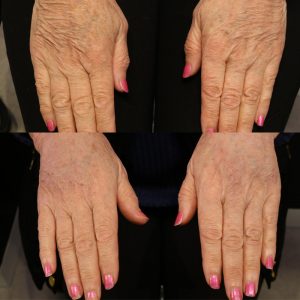It is often said that the face, neck and hands are the areas that reveal your age. We often rejuvenate or treat the face and neck and neglect the hands. The hands can be a ‘give-away’ to your age if not given the proper attention.
This volume loss can be replaced with dermal fillers or collagen stimulators. These are often more well-known for facial rejuvenation and revolumisation. Like the face, the hands can also show signs of ageing through volume loss and dermal fillers can be used in a similar manner to replace volume loss here. Naturally, fat can be lost in the back of the hands with ageing, leading to problems such as;
- wrinkly skin
- excess show of tendons
- prominent veins
By replacing volume in the back of the hands, the above concerns can be addressed.

There are three main methods of improving volume in the back of the hands;
- Dermal fillers – are the most popular method of revolumising the face and can also be used in the hands. The most common type of fillers used are composed of hyaluronic acid. This is a temporary filler but has the ability to last several years. The average amount of filler used per hand is 1mL, but this will vary depending on the age and degree of volume loss.
- Collagen stimulators – collagen stimulators also provide additional volume to the back of the hands. As the name suggests, they trigger the body to create more collagen and therefore volume in the skin. There are two main types of collagen stimulators. The first type contains only the collagen stimulator. As it often takes 2 or more months for collagen to begin working, there are no results during this time for this type of collagen stimulator. The second type contains both a temporary filler as well as a collagen stimulator. The temporary filler provides some volume whilst the collagen stimulator is working. The temporary fillers usually dissipate once collagen production has commenced. This allows the patient to see the results of volume replacement immediately without delay. The overall effect of collagen stimulators on volume can also be years.
- Autologous fat transfer – this is a procedure that utilises your own fat to provide volume to the back of the hands. Fat is harvested from another area of the body, for example, the abdomen, hips, or thighs. This is done with liposuction. This fat is then injected into the back of the hands in a similar manner to dermal fillers or collagen stimulators. Usually, 2-3 sessions of fat transfer are required for ideal results. The results of this procedure are more permanent than fillers or collagen stimulators.
The method of injecting dermal fillers, collagen stimulators or fat involves the use of a needle or cannula;
- Needle – this simply involves using a needle to puncture the skin over the back of the hands multiple times to inject the product into the hands. As needles are relatively short, this involves injecting boluses, or ‘blobs’, of product and then massaging it flat. The advantages of this method are simplicity and speed. The main disadvantage is the potentially high level of bruising due to each needle puncture having a chance of puncturing a vein.
- Cannula – unlike needles, cannulas are blunt-tipped instruments (rounded tip), with a side port that can weave underneath the skin and inject product whilst doing so. The usual method involves placing two entry points between two knuckles of the hands. This is done with a small amount of local anaesthetic and a needle to pierce the skin. The cannula is then fed through both of these entry points. Using a fanning method with the (long, blunt-tipped) cannula, the volumiser is injected. Less massaging is required as the product is spread out more evenly during the process than with a needle. Pain levels may be similar to using a needle, but cannulas often feel unusual to the patient when used in the back of the hands. Possibly, because it is being passed just under the skin.
Revolumisation fo the hands is an important part of hand rejuvenation. It can also be done alongside laser treatments to help concerns such as pigmentation, or ‘age-spots’ (solar lentigos and seborrhoeic keratosis). It is important to not neglect the hands when rejuvenating the face. The results will complement and help to not ‘give-away’ your age.